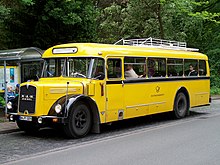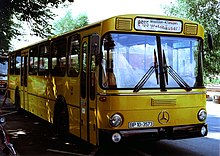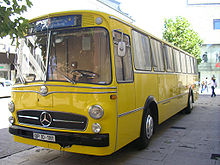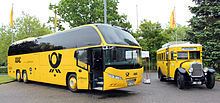Kraftpost
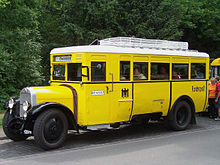

The combined transport of people and mail by the Deutsche Reichspost or Deutsche Bundespost in postal buses as the successor to the stagecoach is called Kraftpost . From 1965 until it was discontinued in 1985, the term postal service was officially used.
From 2013 to 2016, Deutsche Post AG was again active in long-distance bus transport under the Postbus brand .
history

Reichspost until 1945
The first signs "Kraftpost-Halt" were on the Wendeburg- Braunschweig route, since on September 1, 1904, the scheduled delivery of mail with the first Büssing omnibus began there. The first postal service line in Germany was set up by the postal administration of the Kingdom of Bavaria on June 1, 1905 between Bad Tölz and Lenggries . The first overland line was established in the old Reichspost area on June 16, 1906 between Friedberg in Hesse and Ranstadt . A bus from the Süddeutsche Automobilfabrik Gaggenau (SAG) was in use. The wagons used by Kraftpost had rolling letter boxes into which mail could be dropped. After a war-related stagnation in development, Kraftpost experienced its first heyday in the 1920s and early 1930s, when the rural area was opened up with Kraftpost lines. There was a strong north-south divide, as a dense network of railway lines already existed in the north German lowlands , whereas in southern Germany motor post buses were the first connection to larger transport routes in many rural communities. The Kraftpost also served the regional freight transport of mail pieces .
In addition to a dense network of routes, excursions were also organized. The so-called " Deutsche Alpenpost " was an important means of transport in the ski areas of the German Alps . Further long-distance lines in Germany (including Lüneburg Heath Post, Eifelpost, Black Forest Post, Bayerwald Post) and to neighboring countries (Alpen-Adria-Post, Isar-Engadin-Post) were added.
Following the German example, similar postal routes were set up in Austria and Switzerland in 1906 and 1907. These are still operated today under the names Postbus (Austria) and Postbus (Switzerland).
After 1945

Even after the Second World War , a dense route network for Kraftpost was rebuilt in West Germany. In the GDR , the postal service ended in 1953 and was transferred to the districts' state- owned transport companies . Even so, until the 1970s, people were still being transported in postal vehicles on individual routes with little need.
In the mid-1950s, as in the 1920s and 1930s, Kraftpost was once again the largest bus company in Europe with over 4,000 Austrian Post's own buses. The economic decline of the postal bus began at the end of the 1950s due to the growing individual traffic and also due to structural reasons. Even the renaming to "Postreisedienst" in 1965 could not influence this. As a public service company, the Deutsche Bundespost was also obliged to maintain uneconomical lines. The proportion of non-cost-covering traffic with school and social tariffs increased steadily.
In many places, private bus operators have with the operation of postal buses commissioned , particularly in Saarland , in Schleswig-Holstein and Lower Saxony .
Merger with the train bus
In 1971, the rail and post buses were merged to form the rail / post bus transport association with the central office in Frankfurt am Main , which was a pure planning company, while operations remained with the Deutsche Bundesbahn and Deutsche Bundespost. Ultimately, the omnibus traffic community was the trigger for the transition from the postal service to the rail bus service of the Deutsche Bundesbahn, which often operated a bus network in parallel, as a replacement for disused routes or for unprofitable trains.
Nevertheless, in 1974 the postal service had 435 million passengers, the highest number in the 80 years of its existence. The aim of the association was to operate local public transport with buses more economically and to expand it as needed.
Transfer to regional bus companies
For reasons of better economy, four joint regional bus companies ( Autokraft Kiel , Regionalverkehr Hannover , KVG Stade , Regionalverkehr Köln ) were founded as a pilot project in 1976. In the rest of Germany, the German Federal Railroad took over all bus services operated by the railways and post offices between 1981 and 1984 by a decision of the Federal Cabinet of June 25, 1980. In 19 regions, regionalized bus companies separate from the rest of the railway organization were set up on the basis of public law. These were managed as the "Bahnbus business unit (GBB) XY" under the umbrella of the Bahnbus holding company. However, with the exception of the Allgäu region : Here, due to legal concession difficulties (the Bundespost served the Austrian exclave Kleinwalsertal ), Regionalverkehr Schwaben-Allgäu (RVA), a subsidiary of Regionalverkehr Oberbayern (RVO) in the Allgäu, took over the last part of the Post travel service in the federal territory that is still solely subordinate to the Bundespost.
The Deutsche Bundespost was involved in the regional bus company until 1995. These were brought together under the umbrella of the “Vereinigte Bundesverkehrsbetriebe GmbH” (VBG) group of companies. The shareholders of the VBG were the Deutsche Bundesbahn and the Deutsche Bundespost (from 1994 the Deutsche Bahn AG and from 1995 the "Postdienst Beteiligungs-GmbH" (PDB)).
The 1995 postal reform brought an end to the era that had already come to an end ten years earlier with the handover of the last yellow postal buses to the public. The last vehicles procured by the Bundespost in the 1980s were still in use by the successor companies until the 1990s.
The regional bus companies are now integrated into the Deutsche Bahn group under the umbrella of the “DB Regio AG” subsidiary. Four regional bus companies, Regionalverkehr Köln (RVK), Regionalverkehr Hannover (RVH), KVG Stade and Regionalbus Augsburg (RBA) had already been sold to public or private transport companies and local authorities by 1995 .
The history of the Deutsche Bundespost's travel service did not finally come to an end until January 2006, when Peter Brandl, the last official of the Post Travel Service , who served as a bus driver to the end, retired . When the Deutsche Bundesbahn took over the Ingolstadt - Beilngries post bus route, five Ingolstadt post bus drivers fought for a special arrangement, according to which they continued to remain post office workers, but from then on worked in rail buses between Ingolstadt and Beilngries. This regulation remained in place when the regional rail bus company Regionalbus Augsburg (RBA) was privatized.
Post bus
The German Post and ADAC began in October 2013, the establishment of a Germany-wide long-distance bus network . The Postbus started with two daily connections from Cologne to Munich . The ADAC later withdrew from this cooperation, so that Deutsche Post again operated its own long-distance bus network under the Postbus brand until Flixbus took over it in August 2016 .
Legal basis
The transport of users (sic!) In the postal service took place on the basis of the postal travel regulations and thus in a public-law usage relationship. This was also the main difference to a rail bus and the later Postbus company, as there passengers were transported on the basis of private-law transport contracts.
Vehicle fleet
Vehicles from almost all German manufacturers, including Büssing , DAAG , Daimler-Benz , Magirus-Deutz and MAN, were used in the original motor mail service . In the 1970s, standardized intercity buses ( StÜLB ) prevailed, but as a special feature they were provided with a letter box (mostly in the front door area). In contrast to the rail buses, however, Kässbohrer Setra buses remained one-offs that only found their way to the Bundespost through the purchase of smaller bus companies. From the 1960s onwards, in the course of the so-called type adjustment to reduce maintenance costs in the respective upper post offices, only wagons from one manufacturer were procured: in the north of the Federal Republic up to Düsseldorf, Sauerland, Siegerland and Harz, mainly Büssing , later MAN (a small percentage in the 1960s still Daimler-Benz ), up to the axis Saarland, Ludwigshafen and Wiesbaden / Frankfurt mainly Magirus-Deutz and depending on the post office already half Daimler-Benz, south of the axis Frankfurt, Darmstadt, Heidelberg, Ludwigshafen almost exclusively Daimler- Benz, a few MAN models in Bavaria in the 1960s, later MAN Büssing models.
In order to alleviate the shortage of vehicles after the Second World War, defective Mack trucks of the US Army were repaired with the approval of the local commanders and used by the Deutsche Reichspost as provisional mail buses in the immediate post-war period.
Special postage stamps
In the anniversary year 2005 ("Establishment of the first German Kraftpost 100 years ago"), a special postage stamp was published to commemorate Kraftpost. The post bus was also used more often as a stamp motif.
12 Pf value of the Reichspost 1944 with a field post officer with a mail bag in front of a Kraftpost bus (" Field Post in the East ")
20 pfennigs value of the Deutsche Bundespost 1955 with a historic bus from 1906
20 Pf value of the GDR post 1960 on the day of the postage stamp with postal vehicles (" Garant " and a delivery van)
55 + 25 cent surcharge value of the Federal Republic of Germany 2005 on the day of the postage stamp ("100 years Kraftpost")
See also
literature
- Volkhard Stern: Reichspost album - Post omnibuses of the thirties . EK-Verlag Freiburg 2016, ISBN 978-3-8446-6851-3
- Volkhard Stern: With the Kraftpost through Germany . EK-Verlag, Freiburg 2014, ISBN 978-3-88255-854-8
- Volkhard Stern: With the Kraftpost in the post-war years . In: 1945–1949 Germany and the Reichsbahn after the Second World War (= Eisenbahn-Kurier Special 113). EK-Verlag, Freiburg 2014, ISBN 978-3-8446-7006-6 , pp. 82-89
- Volkhard Stern: Eighty years of Kraftpost in Germany . In: Archive for German Postal History , Issue 2/1989, Society for Postal History eV, Frankfurt 1989, ISSN 0003-8989 , pp. 7–90
- Volkhard Stern: Chronicle of the Kraftpost . Brekina , Teningen 2005, ISBN 3-00-015453-1
- Jörg-Michael Hormann and Volkhard Stern: The Postbus is coming - 100 years of Kraftpost in Germany . Deutsche Post AG, Bonn 2005
- Volkhard Stern: With the Kraftpost through the Black Forest . EK-Verlag, Freiburg 2009, ISBN 978-3-88255-851-7
-
Manual dictionary of the postal system ; 2nd Edition
- Kraftfahrdienst, pp. 387–391
- Motor vehicle management, p. 391/392
- Driver staff of the Deutsche Bundespost, p. 392/393
- Vehicle surveillance service, p. 393
- Motor vehicles (II. 1. Vehicles for the postal service), pp. 393–396
- Power Post, p. 404
- Special force post, p. 404
- Ticket, pp. 260–262
- Moving posts; Fare; Reimbursement of fares, p. 262
- Timetable booklets, p. 263
- Postal travel, p. 515
Web links
- Website on the history and importance of Kraftpost
- Kraftpostgeschichtliche Sammlung des Postillion eV
Individual evidence
- ↑ Volkhard Stern: 100 years of Kraftpost . In: The archive. Magazin für Post- und Telekommunikationsgeschichte 1 (2005), p. 16 ff .; here: p. 18.
- ↑ ADAC and Post will start long-distance bus services in October on Handelsblatt online; Retrieved September 10, 2013
- ^ ADAC Postbus line to Munich on Kölner Stadt-Anzeiger online; Retrieved September 10, 2013
- ↑ FlixBus takes over the long-distance bus business of Deutsche Post ( Memento of the original from August 3, 2016 in the Internet Archive ) Info: The archive link has been inserted automatically and has not yet been checked. Please check the original and archive link according to the instructions and then remove this notice. Retrieved August 3, 2016.


